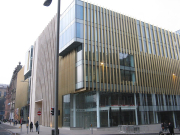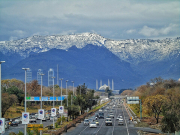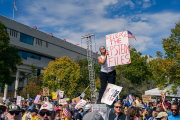
The Mayor of London, Sadiq Khan, has today expanded the area covered by the Ultra Low Emission Zone (ULEZ) from central London up to, but not including, the North Circular (A406) and
South Circular (A205) Roads.
The new zone is 18 times the size of the central London zone and now covers 3.8 million people. Measuring 380km2 it covers one quarter of London and is the largest zone of its kind in Europe. It will bring the health benefits of cleaner air to millions more Londoners, both inside and outside the newly expanded zone. The scheme will operate 24 hours a day, every day of the year except Christmas Day.
The ULEZ expansion, alongside tighter Londonwide Low Emission Zone (LEZ) standards for heavy vehicles introduced in March, are expected to reduce nitrogen oxides (NOx) emissions from road transport by 30 per cent across London in 2021.
The ULEZ is also a crucial step towards the Mayor’s ambitions to tackle the climate emergency and put London on the path to be a net zero carbon city by 2030. It is also an issue of social justice with the poorest Londoners, and Londoners from ethnic minority backgrounds least likely to own a car but also worst affected by toxic air.
A major awareness campaign has been underway over the past three years to ensure drivers and businesses are ready for the ULEZ expansion, with Transport for London’s (TfL) online vehicle checker being used more than 20 million times since 2018. Over a million letters have been sent to owners of non-compliant vehicles seen inside the zone.
The Mayor has provided £61 million in funding for grants for small businesses, charities operating minibuses and low-income and disabled Londoners to scrap their older, more polluting vehicles. However, unlike other Clean Air Zones, London has had no Government support for its scrappage schemes. Despite this, these schemes have helped remove over 12,000 more polluting vehicles from London’s roads, the single biggest such programme in the UK.
The existing ULEZ and the Londonwide LEZ have shown that charging to incentivise emissions reductions works and its impacts on air quality and health are rapid. Before the pandemic, there had been a 44 per cent reduction in roadside nitrogen dioxide concentrations in central London compared to in February 2017 when changes associated with the ULEZ began. The compliance rate for heavy vehicles covered by the Londonwide LEZ is an impressive 95 per cent up, from 48 per cent in February 2017 when the scheme was announced.
Many Londoners have already taken action to prepare ahead of today. Early indications show that 87 per cent of vehicles travelling in the zone already meet the ULEZ standards. This is a dramatic increase in compliance compared to 39 per cent in February 2017, when changes associated with the ULEZ began. This means Londoners are already experiencing the benefits of cleaner air. This is supported by new data, published last week by the Clean Cities Campaign, that London drivers are ditching diesel cars six times faster than the rest of UK*.
This high compliance rate also means that, as the scheme launches, it is expected only 110,000 vehicles each day are likely to need to pay the £12.50 charge. There are a number of options to avoid paying the charge including, walking, cycling, taking public transport, using shared mobility such as a car club or upgrading to a cleaner vehicle.
The expanded ULEZ has the most stringent emission standards, operates for longer hours and covers the largest area of any charging scheme in Europe. It is also a huge technical feat. Together, the Congestion Charge, LEZ and ULEZ require the processing of millions of images and tens of thousands of payments every day.
Crucially these benefits are felt beyond the zone and even beyond London. Environmental Defense Fund analysis found that vehicles that passed through London’s Low Emission Zone for heavy vehicles went on to drive through 95 per cent of the major towns and cities in England and Wales, bringing air quality benefits to a combined population of 18 million people**.
Everyone must take action to help make London’s air safe to breathe and today, to launch the scheme, the Mayor is bringing together Londoners representing communities, emergency services, boroughs, businesses and charities to celebrate the action they’ve taken to help clean up London’s air at an event at the Queen Elizabeth Olympic Park.
The vehicles and organisations represent the many ways Londoners can comply with the ULEZ, including by walking, cycling or using public transport, joining a car club or upgrading to a compliant vehicle. Whilst the Mayor is pleased to see so many organisations showing leadership by moving to electric vehicles, there is no need to purchase a brand-new or electric vehicle to meet the ULEZ standards. Petrol vehicles that meet the standards have been widely available since 2006 and compliant diesel vehicles have been widely available since 2016.
The Mayor of London, Sadiq Khan, said: “This is a landmark day for our city. I pledged to be the greenest Mayor London’s ever had and I am incredibly proud that expanding the Ultra Low Emission Zone today will clean up London’s toxic air pollution and help tackle the global climate emergency by reducing emissions.
“In central London, the ULEZ has already helped cut toxic roadside nitrogen dioxide pollution by nearly half and led to reductions that are five times greater than the national average. But pollution isn’t just a central London problem, which is why expanding the ULEZ today will benefit Londoners across the whole of the city and is a crucial step in London’s green recovery from this pandemic.
“This is also about social justice – we know pollution hits the poorest Londoners, who are least likely to own a car, the hardest, which is why I’m doing everything I can to improve air quality and protect the health of all Londoners. I will not stand by while pollution leads to 4,000 Londoners dying early each year and our children growing up with stunted lungs. The expanded ULEZ is a vital step towards helping combat London’s illegal air and reducing the emissions that are harming our planet.”
Alex Williams, TfL's Director of City Planning, said: “London’s toxic air is a crisis that requires bold action right now. The expanded Ultra Low Emission Zone is vital if we are to help prevent more premature deaths and serious health conditions, as well as tackle the pressing issue of the climate emergency. The central ULEZ that launched in April 2019 was a world first and has already seen harmful nitrogen dioxide slashed by 44 per cent. Today’s expansion of the zone will see the whole city breathing cleaner air.
“More than 20 million motorists have already checked the compliance of their vehicle since 2018, and if you still unsure please use our checker. We are now seeing 87 per cent vehicles in the zone meeting the standard, this is much than we would have expected if the scheme hadn’t been introduced, and it highlights how the scheme has already been effective in cleaning up London’s air. For those liable for the charge, we would ask them to consider walking and cycling where possible, or using public transport. If they do need to drive, car clubs with ULEZ-compliant vehicles, or switching to a cleaner vehicle, are the best options.”
Rosamund Adoo-Kissi-Debrah, founder of the Ella Roberta Family Foundation and World Health Organization Advocate for Health and Clean Air, said: “The coroner’s inquest into my daughter Ella’s death made clear that all levels of government must work to get dirty cars off the road, to protect human health. Children suffer the most from air pollution, as their lungs develop until they are ten. The ULEZ is helping to clean up the air that London’s children breathe from the moment they step out of their homes.”
Sarah Woolnough, Chief Executive of Asthma UK and the British Lung Foundation, said: “Over a quarter of a million Londoners living with asthma and COPD can today look forward to breathing cleaner, healthier air that will reduce their chances of life-threatening asthma attacks and exacerbations, thanks to the ULEZ expansion. Looking across the country, we can see the positive impact that Clean Air Zones are having on communities, making them healthier places for future generations to grow and thrive, by cutting levels of major pollutants that can cause and worsen lung conditions. Whilst this is a huge step in the right direction, we mustn’t be complacent against this invisible threat. The fact of the matter remains that the majority of people living in London, are still living in areas where pollution levels are dangerously high. We therefore look forward to working with the Mayor to ensure ULEZ and other pollution reduction schemes go further and are delivered faster in order to improve the quality of air across the entire capital.”
Anjali Raman-Middleton, 17, Co-founder of Choked Up, said: “We’ve already seen the impact that the ULEZ has had on our air and are thrilled to be supporting its expansion. This is a significant step in cleaning our air and meeting London's target of carbon-neutrality by 2030. Whilst there is still work to be done to ensure that every Londoner breathes easy, ULEZ expansion will improve the health of millions.”
Jordan Cummins, CBI London Head of Policy, said: “The CBI recognises and welcomes the Mayor’s continued commitment to improving London’s air quality. The extension of the Ultra-Low Emission Zone comes at a critical moment, as the UK hosts COP26, and the capital continues to set a world-leading example to global cities on emissions reduction. To achieve this, with business as a partner, it is also critical that we look to secure a cohesive London-wide set of clean air policies – supporting consumers and businesses to make the shift to cleaner vehicles and delivering the charging and refuelling infrastructure that is required to reach the capital’s net zero ambitions.”
Professor Sir Stephen T Holgate, MRC Clinical Professor at Southampton, UKRI Clean Air Champion and Special Advisor to the RCP on Air Quality, said: "Air pollution is a scourge on society, especially harming the young and old as well as those with pre-existing diseases. With the expansion of the ULEZ today, the Mayor of London has taken a vital step that will deliver major reductions in toxic pollutants across London. Reductions that will have significant benefits for the health of all Londoners."
Jane Burston, Executive Director, Clean Air Fund, said: “London continues to be a world leader in developing and implementing ground-breaking clean air policies, designed to improve the health of everyone who lives, works and learns in the city. Where London leads, others will follow. We look forward to seeing more cities in the UK and around the world, inspired by London’s can-do attitude, introducing similar schemes to make our cities healthier, happier places in which to live and grow.”
Simon Birkett, Founder and Director of Clean Air in London, said: “The ULEZ expansion is a vital step on the path to achieving zero tailpipe emissions from vehicles and a beacon of hope in the days before COP26.”
Richard Dilks, Chief Executive of CoMoUK said: “The expansion of the Ultra Low Emission Zone is a symbiotic fit with shared transport options such as car clubs, bike and e scooter share schemes as they all enable Londoners to step away from car ownership. Doing that cuts people’s transport emissions and costs while cleaning up London’s air and delivering more liveable neighbourhoods.” Photo by Photo by DAVID HOLT, Wikimedia commons.








































